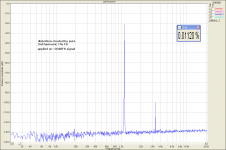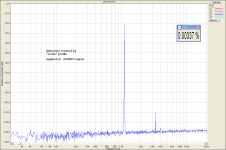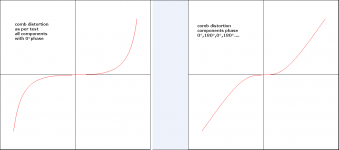Using headphones Sennheiser PX100-II,
I did the test without previously looking at the results,
I run each peace only once.
I very much disliked #1.
#2 was better but I did not like it.
I found #3 the more natural.
I did the test without previously looking at the results,
I run each peace only once.
I very much disliked #1.
#2 was better but I did not like it.
I found #3 the more natural.
Last edited:
No, because at lower signal level the "comb" distortion profile creates only 3rd harmonic (with very very low amplitude), as you can see from my plots at -20dBFS signal posted earlier.
Yes I see, 90 db down compared to 80db for the pure 3rd. A very interesting test.
Thanks Pavel, Just looking at the graphs without analysing them properly the one with the comb of harmonics looks like it should be higher in overall distortion. But when you look at the db levels (and the fact that db's are logarithmic!) then the situation changes.
I wasn't previously aware that just a single harmonic could cause such a mish mash of additional intermodulations.
It is very interesting that in a situation with a predominat 3rd harmonic, with virtually no other harmonics it will sound worse (and as though there are many other harmonics added) than a distortion with many odd harmonics starting about 10db lower but at decreasing levels. This is not something I realized before.
Tony.
I wasn't previously aware that just a single harmonic could cause such a mish mash of additional intermodulations.
It is very interesting that in a situation with a predominat 3rd harmonic, with virtually no other harmonics it will sound worse (and as though there are many other harmonics added) than a distortion with many odd harmonics starting about 10db lower but at decreasing levels. This is not something I realized before.
Tony.
I wasn't previously aware that just a single harmonic could cause such a mish mash of additional intermodulations.
Hi Tony, this fact is often intentionally not provided. The most important view is that it is the non-linearity that defines the distortion. HD or IMD or CCIF are only tools to visualize the issue and to make it more apparent.
There is an excellent application note By Burr-Brown / TI that explains intermodulations:
http://www.ti.com/general/docs/lit/getliterature.tsp?baseLiteratureNumber=sboa077&fileType=pdf
I got here late and stopped when I saw that Pavel was about to reveal and did a quick listen. Here's what I sent him:
Hey Pavel,
I know it's too late, but I stopped reading when I got to your reveal.
I'm NO golden ear and just a quick listen through iFi USB DAC and two headphones: old over the ear AKG-K301 and new IEM Bose IE2.
Wow, another audiophool shattering test, I thought it would be obvious but it wasn't! I'm not sure if I could even tell the difference.
Here's my take:
Track 1 H3 (I meant H3+comb)
Track 2 H1 (I meant just H3)
Track 3 clean
I'll catch up in the thread.
Thanks for a great listening test!
Cheers,
Jeff
.......
These test are so much fun and very humbling. 😱
Oh and Pavel when you said on the first page that you were "one ear", I think you meant the English expression " I'm all ears. "

PS I can't help it, I teach English 😉
Hey Pavel,
I know it's too late, but I stopped reading when I got to your reveal.
I'm NO golden ear and just a quick listen through iFi USB DAC and two headphones: old over the ear AKG-K301 and new IEM Bose IE2.
Wow, another audiophool shattering test, I thought it would be obvious but it wasn't! I'm not sure if I could even tell the difference.
Here's my take:
Track 1 H3 (I meant H3+comb)
Track 2 H1 (I meant just H3)
Track 3 clean
I'll catch up in the thread.
Thanks for a great listening test!
Cheers,
Jeff
.......
These test are so much fun and very humbling. 😱
Oh and Pavel when you said on the first page that you were "one ear", I think you meant the English expression " I'm all ears. "

PS I can't help it, I teach English 😉
Last edited:
Oh and Pavel when you said on the first page that you were "one ear", I think you meant the English expression " I'm all ears. "
PS I can't help it, I teach English 😉
Definitely, and thanks both for your listening impressions and improving my English 😉
I think there's a gocha, though : both wavs were generated with input signal at full scale... and the test music is pretty hot...
However, if the device under test was an amplifier (or anything after the volume control) and/or the music was quieter (ie, the quiet parts of a classical piece), then the signal amplitude would be much lower, and ...
- the pure H3 transfer function would produce a lot less of it
- however, the crossover-style transfer function would produce pretty much the same amount of distortion, which relative to a much smaller signal, would be a lot uglier.
A way to test this would be to add some attenuation before and some gain after your distortion generator (I suppose everything runs in double precision, so this shouldn't cause numeric problems)....
However, if the device under test was an amplifier (or anything after the volume control) and/or the music was quieter (ie, the quiet parts of a classical piece), then the signal amplitude would be much lower, and ...
- the pure H3 transfer function would produce a lot less of it
- however, the crossover-style transfer function would produce pretty much the same amount of distortion, which relative to a much smaller signal, would be a lot uglier.
A way to test this would be to add some attenuation before and some gain after your distortion generator (I suppose everything runs in double precision, so this shouldn't cause numeric problems)....
However, .... and/or the music was quieter (ie, the quiet parts of a classical piece), then the signal amplitude would be much lower, and ...
- the pure H3 transfer function would produce a lot less of it
- however, the crossover-style transfer function would produce pretty much the same amount of distortion, which relative to a much smaller signal, would be a lot uglier.
I am sorry, but this is not true, and I must repeat myself and attach again the distortion result for -20dB amplitude. You need to take into account absolute values of harmonics as well and not only the distortion profile. Popular magazines have done a lot of bad job in this respect, supported by some "gurus". I need for you to check my second post in this thread and also the fact that THD of 3H distortion is 1% and THD of comb distortion was 0.36%, both re full scale amplitude.
Attachments
Last edited:
My bad, I got carried away, thinking the one with the spray of harmonics was modeling crossover distortion.
Very interesting results, Pavel. My guess was, as stated in my 2nd PM, that the comb distortion would have sounded "worse" - but, not so ...
The fact that 'mulched' sound often appeals more matches my own experiences over the years - nominally 'super clean' reproduction is often the hardest barrier to overcome, because it's "squeaky clean", with the emphasis on squeaky - the remanent artifacts can be so annoying at this point, that it would be preferable for many to have some 'soothing' distortion added ... 🙂
Frank, awesome!
The comb of higher orders is likely generating self masking effects when applied to music content, where instruments with harmonic content dominate.
Transients from any giving source within mix boost levels of all other signals present and have an impact.
Phasing of harmonics has likely impact too.
Speaker driver distortion profile is convolved into result as well.
My bad, I got carried away, thinking the one with the spray of harmonics was modeling crossover distortion.
It's OK. I have not modeled cross-over distortion. Nonlinearity here is polynomial as:
y= ax + bx3 + cx5 + dx7 + ....
(x3 is third power of x etc.)
This nonlinearity has smallest deviation from straight line for x close to zero and highest deviation (nonlinearity) for maximum x amplitude.
Phasing of harmonics has likely impact too.
Excellent comment. Under test, all comb components had 0° phase. When phase of components is flipped 0° and 180°, we get transfer function deviation from straight line as attached, with much higher impact at low levels.
Attachments
Could you show the polynom you used (or source code), I'd like to try something...
3H -50dB phase 0°
5H -60dB phase 0°
7H -70dB phase 0°
9H -80dB phase 0°
11H -90dB phase 0°
13H -100dB phase 0°
15H -110dB phase 0°
17H -120dB phase 0°
19H -100dB phase 0°
On a slight tangent, this thread is demonstrating why 'terrible' recordings can come good. There are a number of posts here stating that even the "worst" version, track 1, sounds pretty damn good, even though it's 'stinking' with distortion. Which is what you get with a lot of, especially older, recordings, they're riddled with distortion - but it's a certain type of distortion which the listening brain can grapple with, unravel, if there's no comparison stick close by which points out that the sound is inferior.
Thus, super clean reproduction of 'poor' recordings does work, as least for some people - hence the value in aiming for the highest qualities in the playback system.
Thus, super clean reproduction of 'poor' recordings does work, as least for some people - hence the value in aiming for the highest qualities in the playback system.
There are a number of posts here stating that even the "worst" version, track 1, sounds pretty damn good, even though it's 'stinking' with distortion.
No sufficient data to draw meaningful conclusion. This is actually the hardest part. If you really like track1, first you should be able to prove that you know how it sounds like, or you can consistently pick that chain in blind. Second, if you trust your ears, you should have no reason to choose the low distortion one. But my hypothesis was that people are not really sure with their taste.
My current conclusion of this situation (has been more than five years) is that people should not just trust their own ears (or trust good ears) as it is not easy to understand "taste".
IMO, there's no reason to prefer higher distortion when it is pure 3H. But fine with mono tonic decrease with 2H dominant, with slightly higher total THD. But distortion is fatiguing, whatever what.
Last edited:
I would agree in the sense that some sort of distortions are fatiguing, but not others. Relatively 'poor' recordings from the 50's, say, will often have high levels of distortion but are highly enjoyable - but if distortion from interference effects enter the equation, the fatiguing attributes skyrocket - I can't wait to turn the music off, or fix the adverse influencing factors ...
I would agree in the sense that some sort of distortions are fatiguing, but not others.
You mean they have different severity...
- Status
- Not open for further replies.
- Home
- General Interest
- Everything Else
- Listening test on math added harmonic distortion


